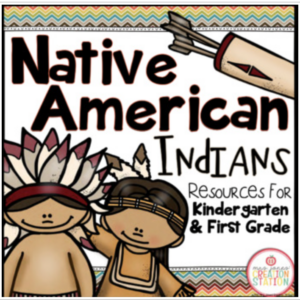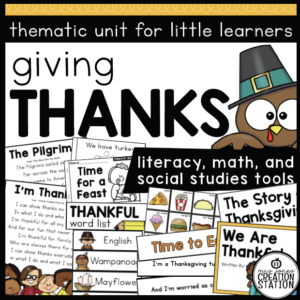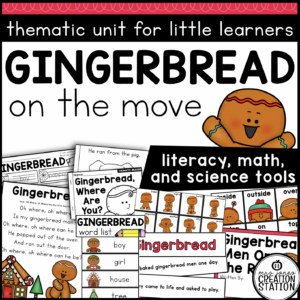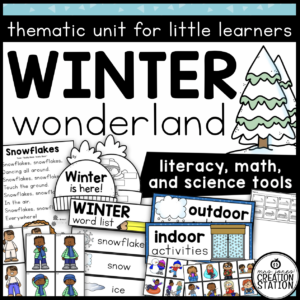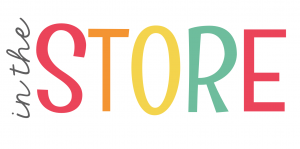Menu
Celebrate Earth Day with a full week of science based activities! These well thought out activities focus on various topics about Earth, and what makes it so unique.
Use the detailed lesson plans and suggested read alouds to help guide your instruction! The whole group activities are a great way to tie in literacy and science. Use the literacy and math centers during your small group teaching time.
Buy the BUNDLE and SAVE! You can purchase this resources in the Thematic Activities for Little Learners Bundle and the Little Learners Mega-Bundle!
Whole Group Lessons: This unit includes five days of whole group activities that build on each other. Start with learning about how to take care of our planet through recycling. Next, move to topics that make Earth so beautiful–landforms, water, rocks and soil.
Suggested Reading List: An amazing list of Earth Day themed picture books will help guide your instruction. Links to purchase books are included.
Thematic Reader: Spark a love for reading and enhance literacy skills with our thematic reader focused on Earth and the beautiful characteristics. Through simple sentences and illustrations, students will focus on fluency and word recognition skills.
Interactive Poem: Foster creativity and language development with our interactive poem centered around Earth. Students will participate in reciting and acting out the poem, reinforcing vocabulary related to our planet.
Math and Literacy Centers: Reinforce key math and literacy concepts with our engaging centers tailored to the theme of Earth Day. From addition practice to measurement and sight words to ending sounds, these centers provide hands-on learning experiences that support academic growth and development.
1. Comprehensive Learning Experience: The unit provides a well-rounded approach to science education, covering various aspects Earth, how we should take care of it and all the characteristics that make it beautiful and unique.
2. Promotion of Curiosity and Inquiry: By digging into the subject of Earth Day, the unit sparks curiosity and encourages inquiry-based learning. Students are motivated to ask questions, make observations, and seek answers, fostering a sense of wonder and exploration in the classroom.
3. Making Real World Connections: Through exposure to age-appropriate science content and vocabulary, students make real world connections from an early age.
WEBSITE | FACEBOOK | INSTAGRAM | PINTEREST | TEACHERS PAY TEACHERS
© Mrs. Jones’ Creation Station, Inc
How can I see what is new in the MJCS store?
Be the first to know about new discounts, freebies, and new products. You can also subscribe to our newsletter to receive access to resources only available to MJCS subscribers, as well as, special offers and ideas!
How can I get credit for my TpT purchases?
Go to your account button at the top of the page. Under the “Buy” section, click “My Purchases “. Beside each purchase you’ll see a Provide Feedback button. Simply click the button and you will be taken to a page where you can give a quick rating and leave a comment for the product. Each time you give feedback, TpT gives you feedback credits that you use to lower the cost of your future purchases. Please leave detailed feedback for each resource, so we are able to create better resources for teachers and students.
How can I find a certain activity in a large PDF file?
If the resource you purchase has a variety of activities compiled into one PDF find the table of contents and click on the activity title. This should take you to that specific activity in the resource.
What can I do if I have a question about a resource?
If you have any questions regarded a resource before purchasing please email me at mrsjonescreationstation[at]gmail.com. Once you have purchased the resource you may use the “Product Q and A” tab on the product page to ask a question, as well.
How do I know if a resource has been updated?
Go to your account button at the top of the page. Under the “Buy” section, click “My Purchases “. Choose to “sort by: recently updated” to see what resources have been updated since you downloaded them last. You can download any updates from there. If a file has been updated, you will see a notification under the resource that says “Newly Updated – Download for Free!”
This item is a paid product created by Mrs. Jones’ Creation Station, Inc. Copying any part of this product, redistributing, selling or placing it on the internet in any form is strictly forbidden and is a violation of the Digital Millennium Copyright Act (DMCA). Thank you for respecting our work!
YES, YOU CAN…
NO, YOU CAN’T…
Click here for a detailed post with step-by-step directions.
You will need to download fonts specified in the resource and install it on your computer before downloading the editable file.
Install the most recent version of Adobe Reader onto your computer. If you have any problems editing, viewing or printing a file make sure your Adobe Reader is updated.
Now you can download the file to your computer. Once the file has downloaded open in Adobe Reader. You should be able to view the editable fields and the text should match the product description. If you have any problems editing the file, make sure you have followed the directions above and then contact me at mrsjonescreationstation[at]gmail.com
